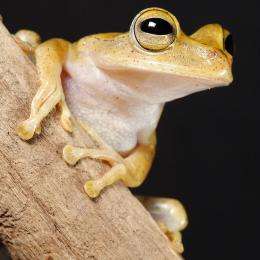Biologist discovers new and wider varieties of frog species in amazon basin than previously recorded

The diversity of frogs in the Amazon Basin is much greater than previously recorded, according to a new paper by Colorado State University and Ecuadorian biologists that could lead to greater understanding of how to save the frogs from extinction.
Chris Funk, assistant professor in the Department of Biology at Colorado State, and his team found a diversity of one- to two-inch-long tree frogs and toadlets that was anywhere from 150 percent to 350 percent greater than originally estimated, according to the paper published today in Proceedings of the Royal Society B. Funk conducted the study with Marcel Caminer and Santiago R. Ron, his counterparts at the Pontifica Universidad Católica del Ecuador.
The scientists sampled specimens in six countries within the Amazon Basin but focused their research in Ecuador. They found an estimated 12 new species. More significant, Funk said, is the percentage increase of new species found using DNA sequences and recordings of frog calls to more accurately identify species.
And if the results of the study are applied to all amphibians in the Amazon, as many as 1,900 new species could be unveiled, which is significant given that amphibians are one of the most threatened groups of animals on Earth, Funk said.
“One of the greatest challenges for biodiversity conservation is a poor understanding of species diversity,” Funk said. “Although the Amazon Basin is already recognized as a global center of biodiversity, we provide new evidence that its diversity is still vastly underestimated. These species have been around for millions of years, but we’re just uncovering them now because we have new technology to do that.”
The team uncovered new species by collecting DNA, measuring physical size and shape, and recording and analyzing frog calls. Differences in calls were more pronounced than size and shape, the study found.
An increase in diversity in species doesn’t equate to less concern for the welfare of amphibians, Funk said. In fact, it could be the opposite: Each frog species has a small range and one event such as a natural or manmade disaster could wipe out an entire species.
Still, the research gives scientists more information about mapping the patterns of diverse frog species so they can begin to understand how to protect them from extinction.
“Given that frogs and other vertebrates are relatively well-studied, there may be even higher levels of undiscovered biodiversity in other understudied taxonomic groups like insects and fungi,” Funk said. “While the Amazon has one of the most species-rich amphibian populations in the world, much is still unknown about the diversity of species there. This is a pressing issue with roughly 41 percent of amphibian species classified as globally threatened with extinction. With this study, we’re showing that, with improved species sampling, that percentage is almost certainly higher worldwide.”
Provided by Colorado State University




















